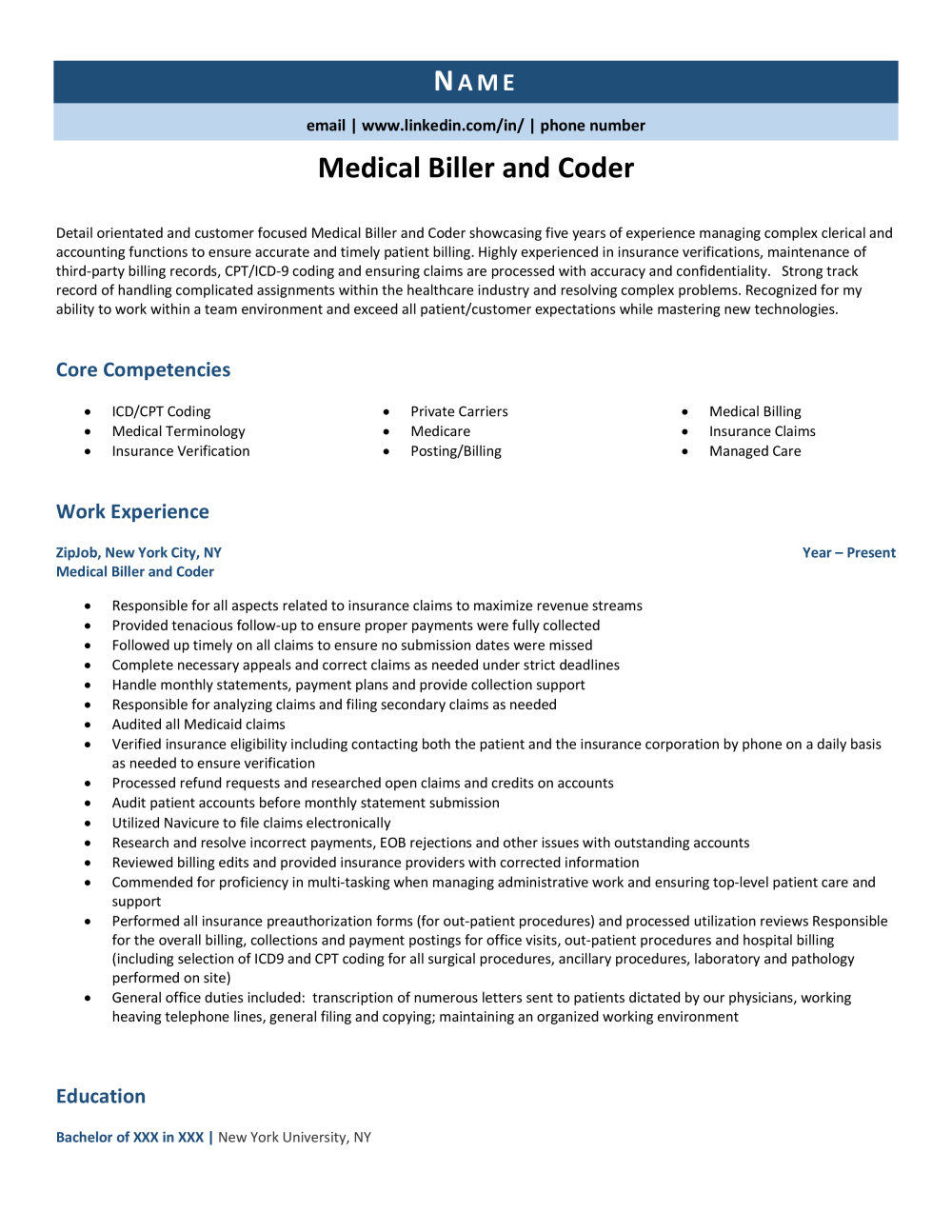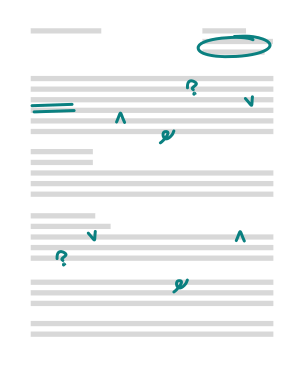Medical Biller and Coder Sample
Download and customize our resume template to land more interviews. Review our writing tips to learn everything you need to know for putting together the perfect resume.
A Medical Biller and Coder oversees billing and coding functions for a medical facility. They review records to determine codes for billing purposes. Below is a general job description of a Medical Biller:
Medical billers are responsible for the billing and collection of medical debts. They work in an administrative capacity to ensure that patients are billed swiftly, accurately and with as much clarity as possible. Every time a patient receives medical attention, the appropriate payments are tallied up by the biller and issued in the appropriate format (by mail, online, or a combination of both). It's very important for medical billers to be able to understand the varying complexities of medical billing; this extends to different types of insurance plans, government assisted programs (Medicaid, Medicare, etc.), and how other discounts are applied to different groups of people. Payscale
Expert Tip
You should never use a creative resume
Many job seekers think that an eye-catching resume template will help them stand out to hiring managers and increase their chances of landing an interview. This is a myth put out by resume builders that value design over content.
The truth is that most hiring managers prefer a traditional resume format.
Creative resume templates, like the one pictured here, can actually hurt your chances of landing an interview. Instead, you should use a basic resume format that quickly communicates your basic information and qualifications–like the one included below.
Medical Biller and Coder resume (text format)
How confident are you feeling about your resume? If you need more help, you can always refer to the following resume sample for a position.
Name
Title
City, State or Country if international
Phone | Email
LinkedIn URL
MEDICAL BILLER AND CODER PROFESSIONAL
Detail orientated and customer focused Medical Biller and Coder showcasing five years of experience managing complex clerical and accounting functions to ensure accurate and timely patient billing. Highly experienced in insurance verifications, maintenance of third-party billing records, CPT/ICD-9 coding and ensuring claims are processed with accuracy and confidentiality. Strong track record of handling complicated assignments within the healthcare industry and resolving complex problems. Recognized for ability to work within a team environment and exceed all patient/customer expectations while mastering new technologies.
CORE COMPETENCIES
ICD/CPT Coding
Medical Terminology
Insurance Verification
Private Carriers
Medicare
Posting/Billing
Medical Billing
Insurance Claims
Managed Care
PROFESSIONAL EXPERIENCE
Medical Biller and Coder
ZipJob, New York NY | Year to Year
Responsibilities
Responsible for all aspects related to insurance claims to maximize revenue streams
Provided tenacious follow-up to ensure proper payments were fully collected
Followed up timely on all claims to ensure no submission dates were missed
Complete necessary appeals and correct claims as needed under strict deadlines
Handle monthly statements, payment plans and provide collection support
Responsible for analyzing claims and filing secondary claims as needed
Audited all Medicaid claims
Verified insurance eligibility including contacting both the patient and the insurance corporation by phone on a daily basis as needed to ensure verification
Processed refund requests and researched open claims and credits on accounts
Audit patient accounts before monthly statement submission
Utilized Navicure to file claims electronically
Research and resolve incorrect payments, EOB rejections and other issues with outstanding accounts
Reviewed billing edits and provided insurance providers with corrected information
Commended for proficiency in multi-tasking when managing administrative work and ensuring top-level patient care and support
Performed all insurance preauthorization forms (for out-patient procedures) and processed utilization reviews Responsible for the overall billing, collections and payment postings for office visits, out-patient procedures and hospital billing (including selection of ICD9 and CPT coding for all surgical procedures, ancillary procedures, laboratory and pathology performed on site)
General office duties included: transcription of numerous letters sent to patients dictated by our physicians, working heaving telephone lines, general filing and copying; maintaining an organized working environment
EDUCATION
Complete School Name, City, St/Country: List Graduation Years If Within the Last Ten Years
Complete Degree Name (Candidate) – Major (GPA: List if over 3.3)
Relevant Coursework: List coursework taken (even include those you are planning on taking)
Awards/Honors: List any awards, honors or big achievements
Clubs/Activities: List clubs and activities in which you participated
Relevant Projects: List 2-3 projects you have worked on
Everything you need to write your medical biller and coder resume
Now that you’ve seen an example of a job winning Medical Biller and Coder resume, here are some tips to help you write your own. You should always begin with a summary section. Remember to use basic formatting with clear section headings and a traditional layout. Finally, be sure to include top skills throughout your resume. We’ve included several examples common for Medical Biller and Coder below.
Let’s start with your resume summary section.
1. Summary
The resume summary replaces the out-of-date resume objective. A summary outlines the most impressive parts of your resume for easy recall by your potential employer, while also serving to fill in personal qualities that may not appear elsewhere on the page. Remember that summaries are short and consist of pithy sentence fragments! You can check out the Medical Biller and Coder resume example for more information!
Expert Tip
Always start with your most recent positions at the top of your resume. This is called reverse-chronological format, and keeps your most relevant information easy for hiring managers to review.
2. Formatting
Our experts recommend you start your resume with a resume summary, like the one above. Other common sections are Work Experience, Education, and either Skills or Core Competencies. Here are some guides from our blog to help you write these sections:
Some resumes will include other sections, such as Volunteer Experience or Technical Skills. When it comes to what sections you need to include on your resume, you will know best!
Other sections for you to consider including are foreign language skills, awards and honors, certifications, and speaking engagements. These could all be relevant sections for your resume.
3. Appropriate skills
Your resume should include all your skills that are relevant to your target job. Skills include both hard skills and soft skills. Hard skills are the technical know-how you need to complete a job, such as data analysis or HTML. You can include hard skills in your core competencies section. Soft skills are harder to quantify, so they require more information to explain your aptitude. Some top soft skill examples include communication, problem solving, and emotional intelligence. Use several examples of how you use your key soft skills throughout your work history, profile summary, and resume title.
4. Experience section
Your Work Experience section should make up the bulk of your resume. This section should include your relevant job titles, companies that employed you, and the dates you were employed.
Your Work Experience section should make up the bulk of your resume. This section should include your relevant job titles, companies that employed you, and the dates you were employed. Most people will finish this section by listing daily duties in short bullet points. Don't be one of them! To make your resume stand out, you need to add your accomplishments and key skills to your resume's Work Experience section. Here are three tips from our experts:
Use the STAR method to describe a situation, task, action, and result. This is adapted from a behavioral interview technique, so interviewers will recognize the format. it's also a great chance for you to organize your key accomplishments.
Don't forget about LinkedIn! The majority of employers are going to look you up on LinkedIn, so it's smart to make sure your LInkedIn profile is up to date and include your URL in your resume's contact section.
Always include a cover letter. Not everyone will bother, so it helps you look like a serious job applicant. It's also your chance to introduce yourself: who you are, why you're applying for this job, and how you want to proceed.
Let’s wrap it up!
Standout resumes will include a resume summary, a traditional reverse-chronological layout, and the skills and experience relevant to your job target. This resume example shows how to include those elements on a page. It’s up to you to insert your personal compelling qualifications.
Keep your resume format easy to scan by both humans and computers; our resume template is designed by our experts to satisfy both audiences. And be sure to include your own skills, achievements, and experiences. Job-winning resumes are resumes that successfully market you, leading recruiters and hiring managers to want to learn more!
Finally, emphasize your interest with a customized cover letter. When writing, remember that the resume and cover letter should support each other. Check out our cover letter tips and examples for more advice.
Didn’t get the specific answers you were looking for on this page? Hire a professional resume writer to get the advice you need to land your next job.
Related posts:




